The BSA Shooting Sports Manual provides comprehensive guidelines for safe and responsible firearms and archery activities in Scouting programs. It ensures youth participants develop skills while emphasizing safety, ethics, and sportsmanship.
Overview of the Manual
The BSA Shooting Sports Manual is a comprehensive guide designed to support shooting sports directors, Rangemasters, and unit leaders in delivering safe and engaging programs. It covers activities for Cub Scouts, Scouts BSA, and Venturing, providing detailed instructions for archery, rifle, shotgun, and BB gun shooting. The manual emphasizes safety protocols, proper equipment use, and age-appropriate guidelines. It serves as a single resource for all BSA-approved shooting sports, ensuring consistency and adherence to safety standards while promoting skill development and ethical practices among participants.
Purpose and Scope
The purpose of the BSA Shooting Sports Manual is to establish standardized safety guidelines and best practices for shooting sports activities within Scouting programs. Its scope encompasses all BSA-approved shooting disciplines, ensuring that participants, instructors, and Rangemasters adhere to consistent safety protocols. The manual is designed to promote responsible firearms and archery practices while fostering skill development, teamwork, and sportsmanship among youth participants. It applies to all levels of Scouting, including Cub Scouts, Scouts BSA, and Venturing programs, ensuring a unified approach to shooting sports education and safety across the organization.

General Information About BSA Shooting Sports
BSA Shooting Sports promotes safe, educational, and fun experiences for youth, emphasizing proper techniques, safety protocols, and sportsmanship across various shooting disciplines and programs.
History of Shooting Sports in BSA
Shooting sports have been a part of BSA programs since the early 20th century, emphasizing safety, skill development, and ethical practices. The 2011 manual update ensured alignment with modern safety standards and expanded opportunities for Cub Scouts, Scouts BSA, and Venturers. Collaborations with organizations like the NRA have enriched training resources, fostering responsible firearms education and promoting character growth through structured activities.
BSA’s Approach to Safety
Safety is central to BSA’s shooting sports programs, with strict guidelines ensuring responsible firearm and archery use. The manual outlines detailed protocols for range operations, emergency response, and proper equipment handling. Supervision by certified instructors and Rangemasters is mandatory, and participants are taught to prioritize safety above all else. This approach fosters a culture of accountability and preparedness, ensuring a secure environment for youth to learn and enjoy shooting sports responsibly.
Structure of the Manual
The BSA Shooting Sports Manual is organized into clear sections, each addressing specific aspects of shooting sports. It begins with an introduction and overview, followed by general information, safety guidelines, instructor requirements, and shooting disciplines. The manual also covers age-specific guidelines, equipment requirements, range operations, and updates. This structured approach ensures that all necessary information is accessible and easy to follow, providing a comprehensive resource for leaders and participants to ensure safe and effective shooting sports activities within Scouting programs.
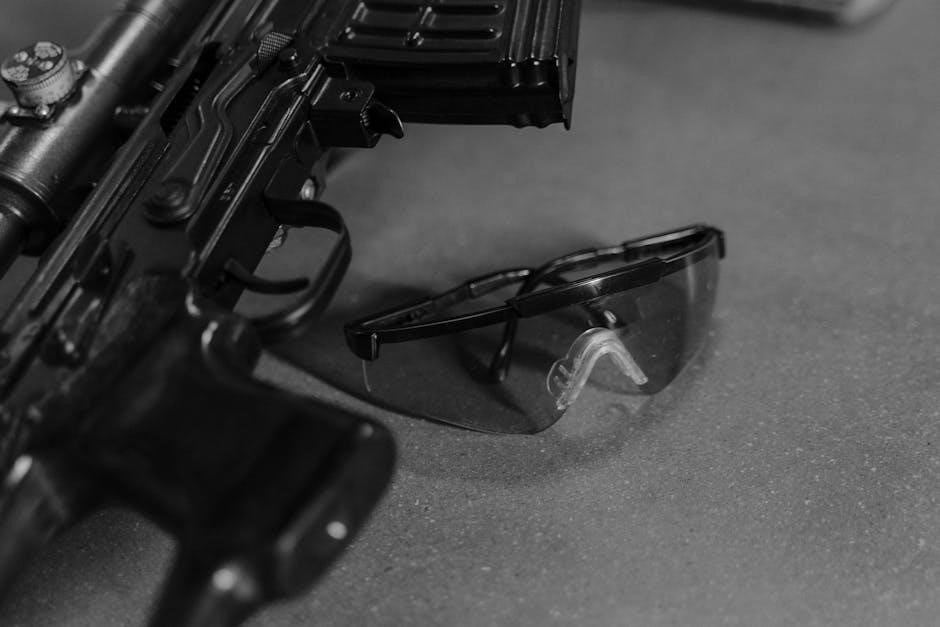
Safety Guidelines and Protocols
The manual emphasizes strict safety protocols, including emergency response plans, range rules, and firearm handling procedures, ensuring a secure environment for all shooting sports activities.
Range Safety Rules
The BSA Shooting Sports Manual outlines essential range safety rules to ensure a secure environment. Key protocols include maintaining a safe distance from shooters, keeping firearms unloaded when not in use, and wearing protective gear like eye and ear protection. All participants must follow commands from certified Rangemasters and remain behind designated shooting lines. Firearms must be pointed downrange at all times, and no horseplay or distracting behavior is allowed. These rules are designed to prevent accidents and promote disciplined, responsible shooting practices for all participants.
Firearm Handling Procedures
The BSA Shooting Sports Manual emphasizes strict firearm handling procedures to ensure safety. Firearms must always be treated as loaded, with actions kept open and magazines removed until ready to shoot. Participants should never point firearms at people or non-target areas. Loading and unloading must occur under direct adult supervision, with the muzzle always pointing downrange. Shooters must use the buddy system to ensure compliance with safety rules. Firearms should be stored securely when not in use, and all handling must adhere to NRA guidelines and Rangemaster instructions to prevent accidents and promote responsible gun handling.
Emergency Response Plans
The BSA Shooting Sports Manual requires units to establish clear emergency response plans before any shooting activity. These plans must include procedures for injuries, equipment malfunctions, and natural disasters. Leaders should ensure immediate first aid is available and know the nearest medical facility. Emergency contact information must be accessible, and all participants should be trained on evacuation routes. Regular drills are recommended to prepare everyone for potential incidents. Proper communication and quick action are critical to minimizing risks and ensuring a safe environment for all participants in shooting sports activities.

Instructor and Rangemaster Requirements
Instructors must be BSA-registered, NRA-certified, and complete required training. Rangemasters oversee safety and ensure compliance with BSA guidelines. Certification ensures expertise in firearm handling and safety protocols.
Qualifications for Instructors
Instructors must be NRA-certified and BSA-registered, with completion of specific training programs. They must be at least 21 years old and demonstrate expertise in firearm safety and handling. Certification ensures instructors can teach safely and effectively, adhering to BSA guidelines. Training sessions cover rifle, shotgun, and archery disciplines, preparing instructors to lead youth in responsible shooting sports activities. Instructors must also stay updated on the latest BSA Shooting Sports Manual to ensure compliance and provide high-quality instruction.
Role of Rangemasters
Rangemasters are responsible for ensuring a safe and controlled shooting environment. They oversee all range activities, enforce safety protocols, and supervise instructors and participants. Rangemasters must be NRA-certified and BSA-trained, with expertise in firearm handling and range operations. Their role includes inspecting equipment, managing target placement, and addressing emergencies. They also ensure compliance with BSA guidelines and maintain order during shooting sessions. The rangemaster’s primary focus is on safety, providing a structured and educational experience for Scouts and leaders alike.
Training and Certification Process
The training and certification process for BSA shooting sports instructors and rangemasters involves NRA certification and BSA-specific modules. Individuals must be at least 21 years old and complete hands-on training, covering firearm safety, range management, and instructional techniques. Certification ensures they can teach safely and effectively, adhering to BSA guidelines. Continuous education is required to maintain certification, ensuring up-to-date knowledge and best practices in shooting sports instruction.
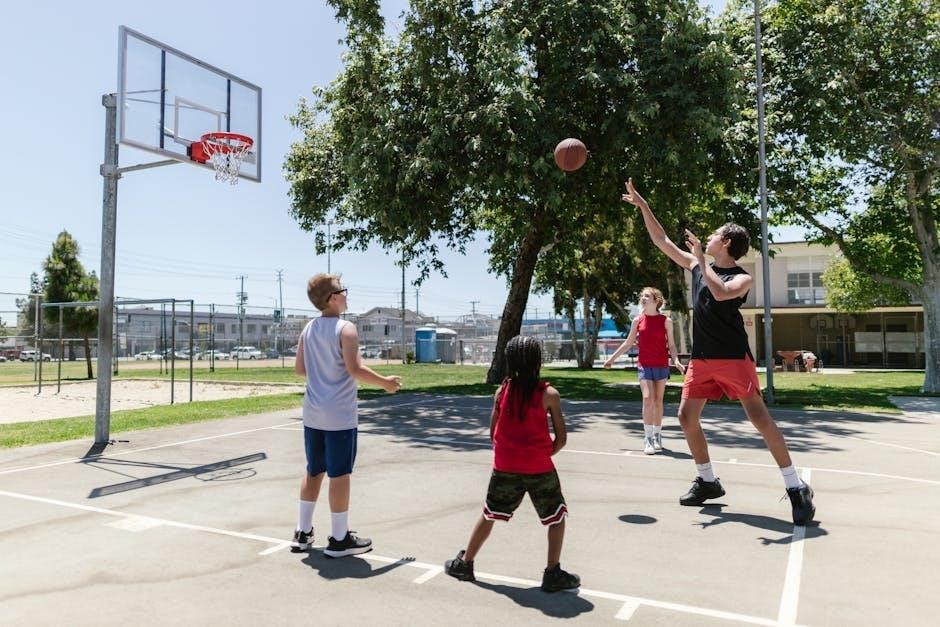
Shooting Disciplines Covered
The manual covers archery, rifle shooting, shotgun shooting, and BB gun safety, providing detailed safety guidelines and proper techniques for each discipline.
Archery
The manual details archery safety protocols, equipment guidelines, and proper shooting techniques. It emphasizes age-specific programs, ensuring youth learn fundamental skills under qualified instructors. Safety is paramount, with strict guidelines on equipment inspection and range setup. The manual also outlines training requirements for archery instructors, ensuring they are certified to teach proper form and safety practices. Archery activities are designed to promote skill development, teamwork, and sportsmanship, aligning with BSA’s commitment to character-building experiences. Regular inspections and adherence to safety standards ensure a secure environment for all participants.
Rifle Shooting
Rifle shooting is a core discipline covered in the BSA Shooting Sports Manual, emphasizing safety, skill development, and responsible firearms handling. The manual outlines specific guidelines for rifle programs, including equipment selection, range setup, and instructional methods. Youth participants learn fundamental marksmanship skills, proper rifle maintenance, and ethical shooting practices. Certified instructors and rangemasters ensure adherence to safety protocols and provide structured training. The manual also addresses age-specific requirements, ensuring activities are appropriate for Cub Scouts, Scouts BSA, and Venturing programs. Rifle shooting fosters discipline, focus, and teamwork while promoting a deep respect for firearms and their safe use.
Shotgun Shooting
Shotgun shooting is a popular discipline within the BSA Shooting Sports Manual, focusing on safe and enjoyable participation. The manual provides detailed guidelines for shotgun activities, including equipment selection, range setup, and proper techniques. Youth participants learn to handle shotguns responsibly, understand ammunition types, and master shooting fundamentals. Safety protocols are emphasized, with specific rules for loading, firing, and storing shotguns. Certified instructors ensure adherence to best practices, while age-specific guidelines ensure activities are appropriate for Scouts BSA and Venturing programs. Shotgun shooting promotes skill development, teamwork, and respect for firearms in a controlled environment.
BB Gun Safety and Use
The BSA Shooting Sports Manual emphasizes BB gun safety, outlining proper handling and usage for youth participants. It specifies that BB guns are classified as firearms, requiring strict adherence to safety rules. The manual details guidelines for rangemasters, who must be registered with BSA, and ensures that all activities are conducted in a controlled environment. Proper techniques, such as eye protection and muzzle control, are highlighted to prevent accidents. Emphasis is placed on building responsibility and marksmanship skills in a safe and structured setting, aligning with BSA’s commitment to youth safety and education.

Age-Specific Guidelines
The BSA Shooting Sports Manual provides age-specific guidelines for Cub Scouts, Scouts BSA, and Venturing programs, ensuring activities are appropriate for each group’s maturity and skill levels.
Cub Scouts Shooting Sports
The BSA Shooting Sports Manual outlines specific guidelines for Cub Scouts, focusing on BB gun and archery activities. These programs are designed to introduce younger scouts to shooting sports under close adult supervision. Safety, proper technique, and age-appropriate challenges are emphasized to ensure a positive experience. The manual provides detailed instructions for range setup, supervision requirements, and skill development, ensuring Cub Scouts can enjoy shooting sports responsibly and safely while building foundational skills and confidence.
Scouts BSA Shooting Activities
For Scouts BSA, the manual outlines advanced shooting sports activities, including rifle, shotgun, and pistol use. Emphasizing safety and skill development, these programs are designed for older youth, preparing them for competitions and leadership roles. The manual specifies training requirements, supervision ratios, and range operations, ensuring Scouts gain proficiency and confidence in handling firearms responsibly. It aligns with NRA standards, fostering a culture of safety and excellence in shooting sports within Scouts BSA.
Venturing Shooting Sports Programs
Venturing shooting sports programs are designed for young adults, offering advanced training in disciplines like muzzleloading, pistol shooting, and competitive rifle events. The manual provides guidelines for Venturers to develop leadership skills while engaging in high-adventure activities. It emphasizes safety, sportsmanship, and skill mastery, with specific protocols for handling firearms and archery equipment. The programs encourage Venturers to take on leadership roles, organizing shooting events and mentoring younger Scouts. Safety remains paramount, with detailed procedures for range setup, equipment maintenance, and emergency response, ensuring a safe and educational experience for participants.
Equipment and Gear Requirements
The manual outlines specific equipment and gear requirements for shooting sports, including firearms, archery gear, and protective equipment, ensuring safe and compliant participation in all activities.
Firearms and Ammunition
The BSA Shooting Sports Manual specifies requirements for firearms and ammunition, ensuring safety and suitability for various age groups and skill levels. It emphasizes proper firearm inspection, storage, and handling procedures. Ammunition must be appropriate for the firearm type and intended use. The manual also outlines guidelines for transporting and storing firearms and ammunition, ensuring they are secured in locked containers when not in use. Additionally, it highlights the importance of using eye and ear protection during shooting activities. Instructors and rangemasters must enforce these standards rigorously to maintain a safe environment. Proper adherence ensures compliance with BSA and NRA guidelines. Regular updates from BSA should be reviewed to stay informed on the latest recommendations and regulations regarding firearms and ammunition usage in Scouting programs.
Archery Equipment
The BSA Shooting Sports Manual outlines specific requirements for archery equipment, ensuring safety and appropriateness for participants. It recommends using recurve, compound, or traditional bows, depending on age and skill level. Arrows must be durable and suitable for the bow type. The manual emphasizes the use of arm guards, finger tabs, and bow sights to prevent injury and improve accuracy. Proper equipment maintenance, such as inspecting bow strings and arrow limbs, is also highlighted. Age-specific guidelines ensure equipment matches the archer’s strength and skill level, promoting a safe and enjoyable experience. All gear must meet BSA and NRA standards.
Protective Gear
Protective gear is essential for all shooting sports activities. The BSA Shooting Sports Manual mandates the use of ANSI-approved eye protection and hearing protection for all participants. Additionally, helmets are required for certain high-impact disciplines. Gloves and arm guards are recommended to prevent injuries from bow strings or firearm recoil. Properly fitted gear ensures safety and comfort. Instructors must verify that all participants wear appropriate protective equipment before engaging in any shooting activity. This ensures compliance with BSA safety standards and helps prevent accidents. The manual emphasizes that protective gear must be inspected regularly for damage or wear.
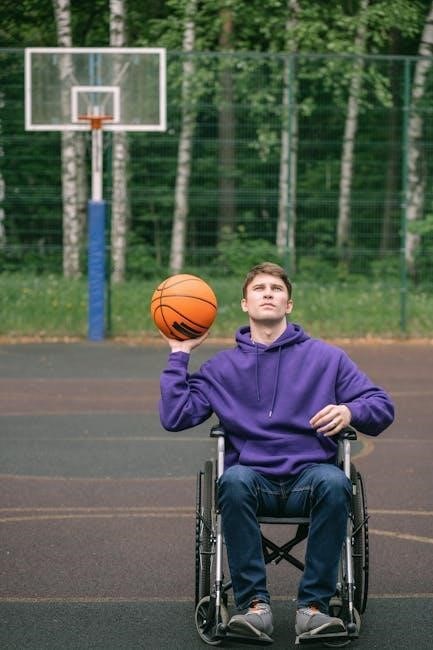
Range Operations and Management
The manual provides detailed guidelines for safe range operations, emphasizing proper setup, maintenance, and supervision. It ensures compliance with BSA standards for a secure shooting environment.
Range Setup and Maintenance
The BSA Shooting Sports Manual outlines detailed procedures for range setup and maintenance to ensure safety and efficiency. Proper target placement, backstops, and clear shooting lanes are emphasized. Regular inspections of the range are required to identify and address potential hazards. Maintenance includes cleaning, repairing equipment, and updating targets. These practices help create a secure and well-organized shooting environment, aligning with BSA’s commitment to safety and responsible firearms handling.
Target Placement and Design
Proper target placement and design are critical for safe and effective shooting sports activities. Targets must be positioned to ensure bullets or arrows impact a safe backstop, minimizing ricochet risks. Designs should be clear and visible, with defined scoring zones to aid in skill assessment. The manual specifies standard distances for archery, rifle, and shotgun events, ensuring consistency across programs. Correct target placement enhances safety, focus, and precision, aligning with BSA’s emphasis on responsible and ethical shooting practices.
Range Safety Inspections
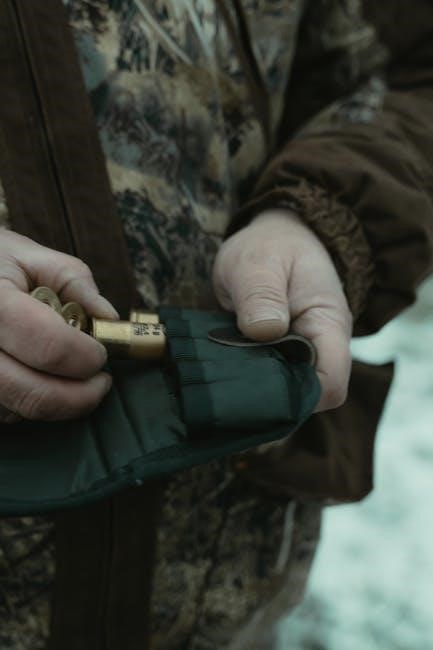
Regular range safety inspections are essential to ensure a secure shooting environment. Inspectors must verify that all targets, backstops, and equipment are in good condition and properly positioned. Check for any hazards, such as debris or uneven terrain, and ensure proper signage is posted. All safety protocols, including first aid kits and emergency communication devices, should be readily available. Rangemasters and instructors must conduct these inspections before and after activities to maintain compliance with BSA guidelines, ensuring a safe and controlled setting for all participants.
Updates and Revisions to the Manual
The BSA Shooting Sports Manual is regularly updated to reflect new safety guidelines, regulations, and best practices. Stay informed through official BSA channels for the latest revisions.
Recent Changes and Additions
Recent updates to the BSA Shooting Sports Manual include enhanced safety protocols, new training requirements for instructors, and expanded guidelines for archery and firearm handling. These changes ensure compliance with current laws and industry standards, promoting a safer environment for all participants. The manual now also covers emerging disciplines and provides clarification on age-specific activities, ensuring it remains a comprehensive resource for Scouting shooting sports programs.
How to Stay Informed
To stay informed about updates to the BSA Shooting Sports Manual, regularly visit the official BSA website and subscribe to their newsletters. Attend training sessions and workshops hosted by BSA or NRA-certified instructors. Additionally, consult the manual’s supplementary resources and FAQs for the latest guidelines. By staying connected to these channels, leaders and participants can ensure they are up-to-date on safety protocols, program changes, and best practices in shooting sports.
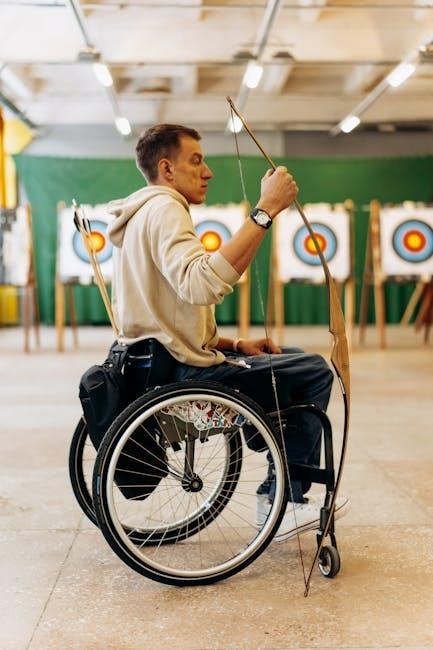
Training and Resources
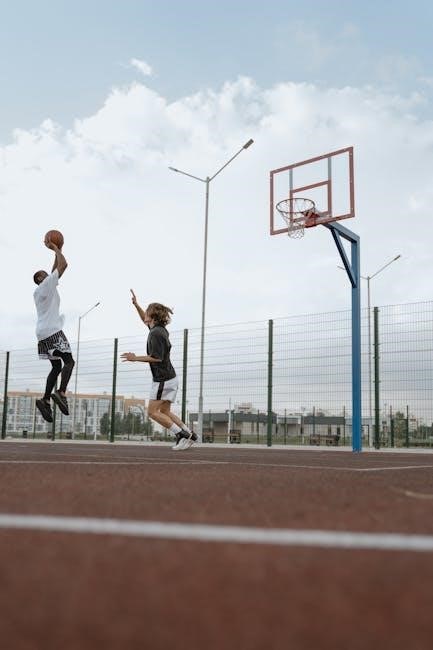
BSA offers NRA certification programs, BSA-specific training modules, and additional resources to ensure leaders and participants are well-prepared for shooting sports activities.
NRA Certification Programs
The NRA offers certification programs for rifle and shotgun instructors, providing comprehensive training in firearm safety, handling, and coaching techniques. These programs are designed to equip instructors with the knowledge and skills needed to teach shooting sports safely and effectively. Certification is recognized nationally and is highly recommended by BSA for leaders involved in shooting sports activities.
BSA-Specific Training Modules
BSA offers specialized training modules tailored to its programs, focusing on safety, youth engagement, and skill development in shooting sports. These modules cover range operations, age-specific guidelines, and activity planning. They emphasize BSA’s commitment to fostering responsibility and leadership while ensuring adherence to safety protocols. The training is designed to complement NRA certifications, providing a comprehensive approach to shooting sports education within Scouting programs.
Additional Resources and Links
Supplement your knowledge with the BSA Shooting Sports Manual and NRA training programs. Access shooting FAQs, age-specific guidelines, and Cub Scout shooting guides. Visit the NRA training page for instructor certifications. Explore BSA’s official website for updates and downloads. Utilize the Cub Scout Shooting Sports Guide for program support. These resources ensure safe, effective, and enjoyable shooting sports experiences for all participants.
The BSA Shooting Sports Manual is essential for promoting safe, ethical, and enjoyable shooting activities. Adherence ensures continuous improvement and fosters responsible practices in all Scouting programs.
Importance of Adhering to the Manual
Adhering to the BSA Shooting Sports Manual ensures safety, consistency, and compliance with established guidelines. It minimizes risks, promotes ethical practices, and maintains BSA’s high standards for youth activities. By following the manual, leaders and participants create a secure environment, fostering responsible shooting sports experiences. Compliance also underscores the organization’s commitment to safety and excellence, ensuring all activities align with BSA’s mission and values.
Continuous Improvement in Shooting Sports
The BSA Shooting Sports Manual is regularly updated to incorporate new safety measures, instructional techniques, and industry standards. Continuous improvement ensures the manual remains relevant and effective, reflecting advancements in equipment and training methodologies. By integrating feedback from instructors, participants, and experts, the BSA enhances the quality and safety of shooting sports programs. This ongoing refinement supports the organization’s commitment to excellence, preparing youth and leaders with the latest knowledge and skills to excel in shooting sports responsibly and safely.
Final Thoughts on Safe Shooting Practices
Safety is the cornerstone of all BSA shooting sports activities. Adhering to the guidelines in the manual ensures a responsible and enjoyable experience for participants. Continuous training and awareness are essential for maintaining high standards of safety. Instructors and leaders play a critical role in modeling and teaching safe practices. By fostering a culture of safety and respect for firearms, the BSA empowers youth to engage in shooting sports with confidence and responsibility, upholding the principles of ethical and safe shooting practices for generations to come.

